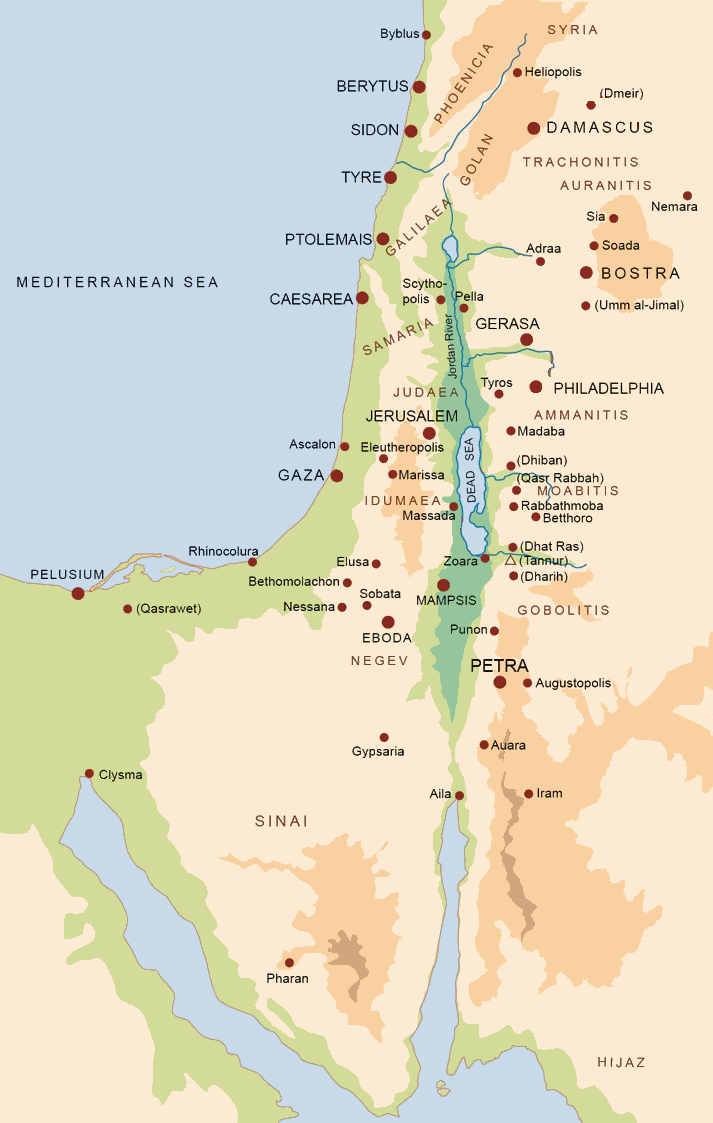A remarkable number of inscriptions from Puteoli documents the presence of Nabataeans. The Nabataean Kingdom was situated to the south of the area we have just visited, comprising the Sinai desert, southern Israel and Jordan, and north-western Saudi Arabia. In 106 AD Trajan made it the province Arabia Petraea, named after the capital Petra. The Nabataeans seem to have spoken Arabic, but used Aramaic for formal documents such as inscriptions. Jesus spoke the Galilean dialect of Aramaic, and some of the Aramaic of our inscriptions has caused quite a few headaches for scholars.

The Nabataeans acted as middlemen in the trade of spices, silk and frankincense from Arabia, India and even China. Their main harbour was Gaza.
While there are many Arabian tribes who use the desert as pasture, the Nabataeans far surpass the others in wealth although they are not much more than ten thousand in number. For not a few of them are accustomed to bring down to the sea frankincense and myrrh and the most valuable kinds of spices, which they procure from those who convey them from what is called Arabia Eudaemon. They are exceptionally fond of freedom. And, whenever a strong force of enemies comes near, they take refuge in the desert, using this as a fortress. For it lacks water and cannot be crossed by others, but to them alone. Since they have prepared subterranean reservoirs lined with stucco, it furnishes safety. Diodorus Siculus, Bibliotheca historica 19.94.4-6. Translation R.M. Geer.
Petra, Jordan. Photo: Wikimedia, Diego Delso.
Hegra, Saudi Arabia. Photo: Wikimedia, Sammy Six.Twelve inscriptions were found in Puteoli, one in Greek, two in Nabataean Aramaic, the others in Latin. The one in Greek is the funerary inscription of Tholomaios, "also called Maximus", who came from Petra (Πετραιος) and died at the age of 33 (IG XIV add. et corr. 842a). Many of the other inscriptions carry the name of one of the main gods worshipped in Petra, Dushara (or Dusares), meaning "the one of Shara", a mountain to the south-east of Petra. He was not represented as a human being, but by a simple stone block. Most likely all these inscriptions belong to a temple of the god (called a mahramta). Over the centuries, many were found in the sea, and the temple must have been in the now submerged Vicus Lartidianus.
One of the two Aramaic inscriptions states that the temple had been built around 50 BC and was enlarged in 5 AD. The other records the offering of two camels, either real animals or depictions, in 11 AD. The Latin inscriptions are on an altar, on marble revetment of the temple, and on bases with cavities in the top for small stones. The latter may have been stone representations of the god. It has been suggested that the names of dedicators were painted on them.
Base with cavities for small stones, DVSARI SACRVM, "dedicated to Dusares".
Museo archeologico dei Campi Flegrei, Baiae.
Photo: Zevi et al. 2008, p. 62.
Top: Aramaic inscription. 11 AD.
Offering of two camels by Zaidu and Abdelge.
Archaeological Museum, Naples.
Photo: Zevi et al. 2008, p. 61.
Right: Aramaic inscription. 5 AD.
Enlargment of a temple. For the well-being of
the Nabataean king and queen Aretas and Huldu.
Museo archeologico dei Campi Flegrei, Baiae.
Photo: Zevi et al. 2008, p. 60.